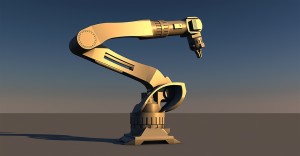 Robots and other automated equipment have become an integral part of the manufacturing industry. They allow companies to manufacture products faster, more efficiently, and with less risk for human injury. But there’s been a growing debate in recent years regarding the impact that robots will have in regards to employment. According to an article published by DigitalTrends, roughly 5 million jobs will replaced by robots by 2020.
Robots and other automated equipment have become an integral part of the manufacturing industry. They allow companies to manufacture products faster, more efficiently, and with less risk for human injury. But there’s been a growing debate in recent years regarding the impact that robots will have in regards to employment. According to an article published by DigitalTrends, roughly 5 million jobs will replaced by robots by 2020.
Not everyone is concerned about robots stealing manufacturing jobs, however. On the contrary, some people believe that it could help strengthen the industry.
Some experts cite the growing number of manufactured exports by China as being a primary reason why manufacturing companies in the United States should embrace robotics and automation. Overseas, manufacturing companies hire low-wage workers to perform tedious, time-consuming tasks. This allows them to sell their products for dirt-cheap, undercutting manufacturing companies in the U.S. who sell products at a higher, more reasonable price.
With that said, even China knows the benefits of robots in the manufacturing industry. Statistics show that Chinese manufacturers purchased twice as many industrial robots in 2015 than their American counterparts (68,000 vs 27,000). If American manufacturing companies want to compete and stay relevant, they must adapt by embracing automation and robotics technology.
You might be wondering how exactly robots are being used in the manufacturing industry. Well, “industrial robots” aren’t necessarily the same robots that you may envision when thinking about robots in popular science-fiction movies. Industrial robots often consist of moving arms and grabbing mechanisms, controlled by a computer or human machine interface (HMI). They look almost like a human arm, featuring joints and a manipulator. They can be used to perform a wide variety of tasks in the manufacturing industry, some of which include lifting heavy objects, assembling objects, manipulating objects into place, welding metal/materials, painting objects, and much more.
Robots are also used extensively on the assembly line. Depending on the specific application, they can also be used in place of human workers, performing the same or similar task.
The bottom line is that manufacturing companies should embrace robotics and automation rather than try to stop it. The technology can help companies produce products more efficiently while cutting down on costs in the process. And as robotics continues to develop, these benefits will only grow for manufacturing companies.
